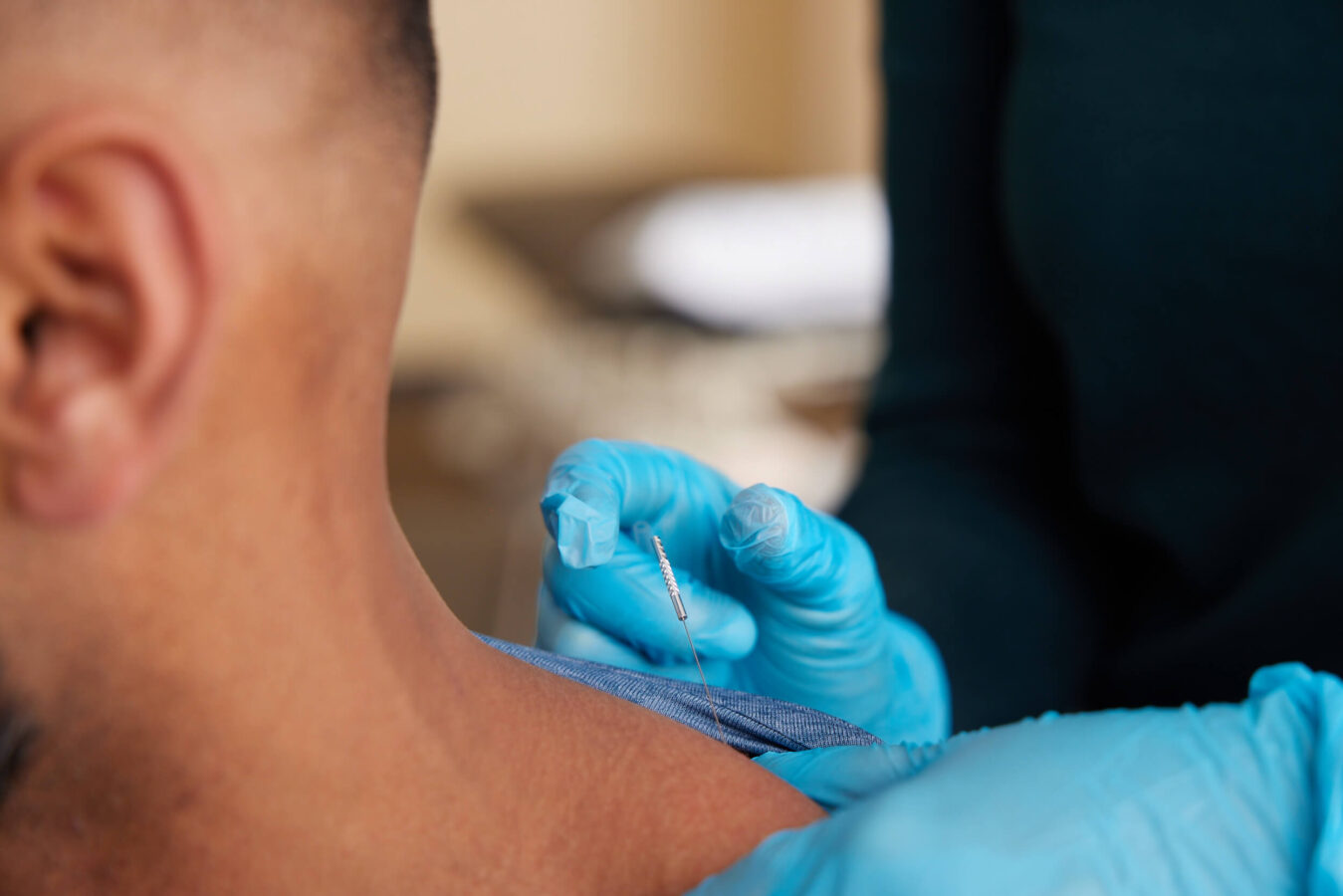
Medically reviewed by Misty Seidenburg
Physical therapists have a wealth of tools and techniques at their disposal to help patients feel, move, and function better. Dry needling is one therapy growing in popularity because of its effectiveness in treating pain caused by tight muscles or sensitive nerves. . Learn about the pros and cons of dry needling to determine if it may be beneficial for you.
Dry needling is the insertion of sterile, filiform needles directly into tight, painful parts of muscle or along the pathway of sensitive nerves located throughout the body. This process causes the muscle to relax and release chemicals that help with tissue healing and pain relief, improving symptoms related to injuries, disease, or functional issues.
Dry needling offers many benefits for many common musculoskeletal injuries and conditions:
1. Minimal Invasiveness & Discomfort
The needles your physical therapist uses for dry needling are thinner than a medical syringe or a sewing needle. In fact, they can be as thin as a human hair.
You may feel the sensation of a “pin prick” or soreness as the needle penetrates the skin and muscle. A drop of blood or two is also normal, but only occurs about 20% of the time. Overall, the discomfort from the procedure is relatively minimal. Many patients actually find it quite relaxing!
2. Natural Pain Relief Without Medication
Dry needling helps with pain relief in two key ways. First, as the needle enters the tight muscle band, it causes it to release and relax, allowing once-restricted areas to move more freely. It also triggers the production of “feel good” endorphins that aid in pain relief. Dry needling offers relief from pain without risky surgery or the need for potentially-addictive pain medications.
3. Improved Mobility and Range of Motion
Trigger points, or taught bands, can contribute to tight, short, and stiff muscles, which in turn restricts ease of movement. As these taught bands release, muscles begin to lengthen and move more freely.
Dry needling before stretching is often more beneficial than stretching alone for releasing muscle bands, particularly if stretching is too painful, or not effective enough to “untie” the knot in the muscle.
4. Increases Blood Flow to Muscles
Prolonged contraction of tight muscle bands leads to insufficient blood flow to the area. This prevents tissues from getting the oxygen and nutrients they need to heal. Dry needling relaxes the smooth muscles of blood vessel walls, allowing them to widen for improved blood flow to the treatment area. This gives damaged tissues the nourishment they need to heal.
5. Treats a Wide Range of Conditions
Dry needling is highly versatile and beneficial for many different musculoskeletal and nerve-related injuries and conditions including:
Dry needling is also safe for use in combination with other therapies. It is just one component of a comprehensive physical therapy treatment plancustomized for each patient’s unique needs and goals.
As a patient, it is important to understand everything involved with a procedure so you can make informed decisions about your own health and wellness.
1. Possible Side Effects: Soreness & Bruising
Your physical therapist inserts a sterile needle into an area that may already be tight, tense, and painful. This can lead to some muscle soreness during and after the procedure, along with bleeding or bruising. These mild side effects typically resolve within a few minutes to 24 hours. (Contact your physical therapist if pain increases or lasts longer than 24 hours.)
2. Risk of Infection
Any time you puncture the skin, there is a possibility of introducing bacteria into the body. However, dry needling needles are stored in sterile packaging. They are removed and used for a single application and disposed of after each use. This significantly reduces the risk of infection.
3. Out-of-Pocket Costs
Because dry needling is still relatively new in the context of Western medicine, many health insurance plans do not cover this treatment. That means out-of-pocket costs for some patients. Treatments can run anywhere from $40 to $100+ per session.
Still, when you compare these costs to copays for pain medication and more invasive procedures, dry needling may be more cost-effective overall. Contact your insurance provider to find out if dry needling is covered, and what you need to submit a claim.
4. Limited Research Due to Funding
If you are the type of person who wants scientific evidence that treatment works before trying it, you should know that research on dry needling is still relatively limited due to funding. That does not mean it does not work.
It simply means more research needs to be done. The data we do have is promising. Studies show dry needling offers immediate and short-term pain relief and mobility improvement.
5. Consult Doctor for Possible Contraindications
Dry needling is not recommended for patients with certain symptoms or conditions. Patients with bleeding disorders, infections, open wounds, compromised immune systems, or taking certain medications should seek other treatments. Also, if you have a serious fear of needles (trypanophobia) this modality may not be right for you.
Dry needling is just one of many physical therapy techniques and treatments available to manage your symptoms and help you recover from an injury or surgery. To learn more about this and other effective ways to treat and manage pain, schedule a consultation with a physical therapist near you.

